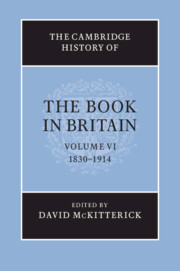Book contents
- Frontmatter
- Introduction
- 1 Changes in the look of the book
- 2 The illustration revolution
- 3 The serial revolution
- 4 Authorship
- 5 Copyright
- 6 Distribution
- 7 Reading
- 8 Mass markets: religion
- 9 Mass markets: education
- 10 Mass markets: children’s books
- 11 Mass markets: literature
- 12 Science, technology and mathematics
- 13 Publishing for leisure
- 14 Publishing for trades and professions
- 15 Organising knowledge in print
- 16 The information revolution
- 17 A place in the world
- 18 Second-hand and old books
- 19 A year of publishing: 1891
- 20 Following up The reading nation
- Bibliography
- Index
- Plate Sections
- References
12 - Science, technology and mathematics
Published online by Cambridge University Press: 28 March 2010
- Frontmatter
- Introduction
- 1 Changes in the look of the book
- 2 The illustration revolution
- 3 The serial revolution
- 4 Authorship
- 5 Copyright
- 6 Distribution
- 7 Reading
- 8 Mass markets: religion
- 9 Mass markets: education
- 10 Mass markets: children’s books
- 11 Mass markets: literature
- 12 Science, technology and mathematics
- 13 Publishing for leisure
- 14 Publishing for trades and professions
- 15 Organising knowledge in print
- 16 The information revolution
- 17 A place in the world
- 18 Second-hand and old books
- 19 A year of publishing: 1891
- 20 Following up The reading nation
- Bibliography
- Index
- Plate Sections
- References
Summary
Hailed as the apotheosis of reason and progress, science became central to defining the meaning of print in the nineteenth and early twentieth centuries. For many readers, cheap periodicals and other products of factory publishing were tangible evidence of spiritual and material progress. Specialist publishing grew rapidly and was often seen as a key sector for innovation. The relation between knowledge and print also changed dramatically, as discovery came to mean previously unknown findings announced in a published journal intended for specialist practitioners. Yet we know surprisingly little about how the press was used after the 1830s to announce novelties and more generally to create images of science and invention.
Since the 1960s, interest in the making of science and technology in the Victorian and Edwardian eras has burgeoned. With a few exceptions, however, the dominant theme of this new literature has been the emergence of the social role of the specialist practitioner. It has been shown how science was transformed through the creation of appropriate institutions, including the British Association for the Advancement of Science and a reformed Royal Society, as well as new educational structures and fresh possibilities for employment in government, industry and the universities. Underlying all these was the emergence of the ‘scientist’ - a term invented in 1833 but which became widely used only towards the century’s end - as gentlemanly, vocational ideals were replaced by the notion that science should be a paid career, independent of church and aristocratic patronage.
Keywords
- Type
- Chapter
- Information
- The Cambridge History of the Book in Britain , pp. 443 - 474Publisher: Cambridge University PressPrint publication year: 2009
References
- 6
- Cited by



